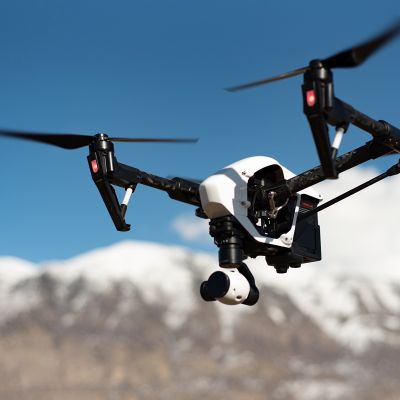When we think of the type of research and innovation required to aid the fight against the global Covid-19 pandemic, our minds may naturally take us to visions of laboratories and hospitals – of vaccine development and research into effective treatments. But in order to truly fight back against this pandemic, collaboration across all fields and industries is required. The Covid-19 recovery is not just about treating and preventing illness. It’s about strengthening the vulnerabilities the pandemic has highlighted in how we used to do things, building resilience to future challenges and ensuring that the Covid-19 crisis doesn’t add to the already looming climate crisis.
Covid-19 has had a huge impact, disrupting almost everything that was previously considered ‘normal’. Recovery will involve not only tackling the spread of the virus itself, but rebuilding our processes to adapt to a new way of doing things – from how we transport goods and respond to fluctuations in demand and supply, to developing manufacturing processes so that we can create what we need without further setting back green initiatives, and finding new ways to monitor possible outbreaks that minimise cost and disruption.
With challenge comes opportunity – could the post-Covid era provide an opportunity to innovate and implement positive changes at a speed previously thought unattainable?
Getting the goods: the use of autonomous drones to deliver medical supplies and alleviate logistical pressures
The Covid-19 pandemic has brought the importance – and potential vulnerability – of supply chain and logistics sharply into focus. Early in the pandemic, we were met with empty supermarket shelves as stores struggled to keep up with a sudden surge in demand. Shortages in personal protective equipment for hospitals and care environments, and issues with getting the right equipment to the right places, at the right time, were widely publicised. Now the latest challenge we face is managing the roll-out of Covid-19 vaccines – the delivery of which Professor Richard Wilding OBE recently described as “one of the biggest logistical challenges we have faced this century”.
With experts warning that Covid-19 will be something we have to learn to live with for many years to come, it’s clear that collaboration across industries will be required to adapt supply chains, logistics and the associated infrastructure to ensure we can respond to future challenges.
Clearly, a shift in supply chain strategies will be necessary. Professor Wilding, Professor of Supply Chain Strategy, has stated that: “In the new normal, if your supply chain is the same as the one that you had pre-coronavirus, you’re probably doing something wrong.” In a DHL white paper, he suggests that the previous focus on procurement for cost-efficiency will be replaced with a shift to procurement for resilience. But it’s not just about looking at our supply chain strategies. It’s also important that we look at new ways to innovate how we are transporting goods to maximise efficiency and resilience.
Already, the vaccine roll-out has been met with logistical difficulties. An article published in December 2020 by The BMJ highlighted that some GPs were calling the roll-out “a “shambles” as delivery delays have forced them to cancel appointments and poor communication has left them waiting all weekend for stock that did not arrive.” Additionally, Supply Chain Briefing outline the potential issue of delivery driver shortages in general, stating that “the use of technology to optimise delivery efficiency has never been more important.” It seems we can’t rely on existing infrastructure alone, and instead we need to drive innovation so that we have multiple options when it comes to how we transport goods and vital supplies.
In October 2020, it was announced that Cranfield University is participating in two research projects focusing on the use of Unmanned Aerial Vehicles (UAVs) for medical delivery purposes. Over 2.5 million movements of medical supplies take place annually in the UK, and the projects could help to speed up these deliveries while also alleviating strain on congested roads. The projects are funded by Innovate UK. The first, led by Skyfarer, seeks to create a flight-testing corridor in Warwickshire – providing the UK’s first drone-based medical deliveries within unsegregated airspace, in a populated suburban environment. The second project works with hospitals and NHS trusts, and will develop the first UK set of standard operational procedures for routine delivery operations.
Discussing the projects, Professor Antonios Tsourdos, Head of the Autonomous and Cyber-Physical Systems Centre, Cranfield University, described autonomous drones as “the ideal solution for efficiently delivering essential goods in compliance with social distancing regulations” and highlighted that the projects could “significantly improve point-to-point movement of critical medical supplies and allow hospitals to get the right product at the right time, quickly and efficiently, while limiting staff exposure to health risks and avoiding cross-contamination.”
Most recently, it was announced that Cranfield will be participating in nine Future Flight Challenge research projects – with researchers from the University’s Centre for Autonomous and Cyberphysical Systems and the soon-to-be-opened new £65 million Digital Aviation Research and Technology Centre (DARTeC) working with industry partners to develop the use of drones to deliver Covid-19 medical supplies to remote areas, and address key infrastructure and air traffic management challenges.
These research projects demonstrate the potential to use innovations in autonomous technology to revolutionise how we transport goods – maximising efficiency, safeguarding against future logistical disruptions and ensuring that essential supplies arrive when they are needed.
A green recovery: sustainable PPE and improved recycling processes
Covid-19 has seen a spike in single-use plastics – from takeaway food packaging, to a huge increase in demand for use-and-dispose medical supplies and personal protective equipment (PPE), such as surgical gloves and face masks. Before Covid-19, single-use plastics seemed to be on the out – but the pandemic has necessitated a resurgence.
A paper published in August 2020, Increased plastic pollution due to COVID-19 pandemic: Challenges and recommendations, highlights that the significant increase in worldwide demand for PPE – with an estimated monthly use of 129 billion face masks and 65 billion gloves required to protect citizens worldwide[1] - was also accompanied by the increased use and disposal of other single-use plastics. For instance, safety concerns about shopping in supermarkets have led consumers to prefer fresh food to be packaged in plastic containers, both to avoid contamination and extend shelf life. According to the paper, the demand for plastics is expected to increase by 40% in packaging and 17% in other applications, including medical uses. In the UK, “it is predicted that if every citizen used one masks per day, it would generate at least 60,000 tonnes of contaminated plastic waste[2].”
Clearly, we face a conflict when it comes to protecting ourselves against the virus and protecting our environment from the impact of this increased use and disposal of plastics. And alongside this increase in how much plastic we’re using, according to a report by Reuters there’s also a trend to create more new plastic due to cut prices from the oil industry:
“The pandemic has intensified a price war between recycled and new plastic, made by the oil industry. […] New plastic, known to the industry as “virgin” material, can be half the price of the most common recycled plastic. Since COVID-19, even drinks bottles made of recycled plastic – the most commonly recycled plastic item – have become less viable. The recycled plastic to make them is 83% to 93% more expensive than new bottle-grade plastic, according to market analysts at the Independent Commodity Intelligence Services (ICIS).”
The need for far greater use of PPE, and the increased demand for single-use plastics, seems inevitable at least for the short-term while the virus remains prevalent in our communities. With this in mind, part of the Covid-19 recovery needs to focus on ensuring our response to this increase in demand can be efficient, cost-effective and environmentally friendly.
At Cranfield, researchers are working in partnership with Meditech Gloves to create natural rubber surgical gloves – using a process which makes them more sustainable, reduces allergens and maximises efficiency. The global medical gloves market is predicted to be worth $70 billion by 2027 – however, most of the gloves produced to satisfy the surge in demand will be made from nitrile rubber, ending up in landfill and remaining there for around 100 years. The research taking place at Cranfield is revising the manufacturing process of natural rubber latex, which biodegrades far quicker, but is limited in use due to skin allergies.
Initial findings have shown that time and energy savings of up to 50% can be achieved and modifications of the formula can deactivate the allergy-causing proteins. This research means that sustainable raw latex could be reintroduced to the industry on a mass scale while also eliminating the protein allergy issue and saving time and energy in the production process – an example of responding to the spike in demand, while using innovative-thinking to ensure the response doesn’t set back climate initiatives.
Research taking place at Cranfield also seeks to improve recycling processes. The University is working with Recycling Technologies and Birmingham and Surrey Universities on a £1.2 million project, which has just received backing from Innovate UK, to develop technology which can improve chemical recycling efficiency to turn waste plastic into a re-usable material. The project will work to further develop Recycling Technologies’ RT7000 technology, which turns hard-to-recycle plastics such as film and laminates into an oil called Plaxx® which can then be used as feedstock for the production of new plastic. Currently, the world only recycles 12% of the 359 million tonnes of plastic produced each year[3]. The collaboration to develop this technology offers a global, scalable solution which will reduce the need to burn, bury or export plastic waste.
Wastewater surveillance to provide an efficient early warning for Covid-19 hotspots
A key element of getting back to something resembling ‘normal’ in a post-Covid world is being able to monitor – and even predict – rises in the virus within our communities, so that we can intervene and prevent wider transmission as soon as possible. However, mass-testing is not only cost and labour intensive – it also disrupts people’s lives. Scientists at Cranfield are collaborating in research which is developing a low-cost method of detecting Covid-19 in wastewater – helping to provide an early warning of future outbreaks and potentially reducing our reliance on mass-testing.
Research has found that most people infected with SARS-CoV-2 – the virus that causes the Covid-19 disease – shed particles in their faeces, even if they are asymptomatic. According to Dr Zhugen Yang, Lecturer in Sensor Technology and Head of the Sensors Laboratory at Cranfield Water Science Institute, “the shedding of SARS-CoV-2 is usually at a very early stage of infection when people may have zero or mild symptoms. Community sewage detection could provide an initial warning of Covid-19 carriers in an area which can then be followed up with more targeted testing.”
Monitoring wastewater could provide an indication of virus hotspots, approximately a week earlier than if we relied on people developing symptoms and requesting a test. As well as providing this vital information earlier, monitoring wastewater is more time, cost and resource-effective than ongoing mass testing – and it doesn’t require the general community to do anything, as the information is gathered while we simply go about our daily lives.
Prior to the Covid-19 pandemic, wastewater-based epidemiology (WBE) research was already being carried out to provide population-level information in areas such as the detection of illicit drugs. However, the pandemic has prompted a global response and seen an increased focus on enhancing WBE research for detecting SARS-CoV-2.
Researchers at Cranfield are taking part in a £1 million national COVID-19 wastewater surveillance programme, led by the UK Centre for Ecology & Hydrology (UKCEH) to develop standardised sampling, testing and scientific modelling methods for WBE that will be adopted by government agencies.
While the science is still very much in its early stages, these collaborative projects prompted by the pandemic provide an opportunity to develop a powerful and efficient tool which could help to not only monitor but predict the spread of the virus – and holds plenty of possibilities for future applications.
However, as Dr Zhugen Yang highlights – there are challenges in developing the methodology to be addressed, such as how we analyse wastewater samples: “Wastewater is an extremely complex matrix. Chemicals, inhabitants and other impurities can all interfere with the detection and accurate identification of particles.” Currently, WBE involves a sample being taken at a wastewater treatment plant and then transported to a laboratory for testing, with a turn-around time of 2-3 days. However, Dr Yang and his team at Cranfield are working to develop low-cost and rapid paper-based devices which can detect SARS-CoV-2 in sewage and could be used at the site of sample collection to give results within a couple of hours – essentially providing real-time monitoring of the levels of viral particles in geographical locations.
The future applications of these devices also hold a great deal of potential – Dr Yang outlined how the devices could be modified and adapted to identify changes in the SARS-CoV-2 virus to give warnings of new variants, and applied in future to detect outbreaks of other diseases such as flu. Furthermore, the fact that they are low-cost and could be used without the need for additional infrastructure such as laboratories, means they could be used in low-setting areas including developing countries. There are challenges, and further research to be done to be able to refine the analysis to get an indication of how many people are carrying Covid-19, rather than just detecting an overall rise, in addition to the need to develop a standardised and reliable testing method. But Dr Yang describes these challenges as a positive opportunity to promote and advance the technology.
Challenges create opportunities
What’s clear, is that the challenges created by the Covid-19 outbreak have also created opportunities to develop new technologies, to drive innovative thinking and to make fundamental changes to the way we do things. As Dr Zhugen Yang put it, “if you have a problem, there are always multiple solutions. People are already adapting – we should be positive, and we are moving forward as we face these challenges.”
In many ways, a desire to innovate became a need to innovate in the wake of Covid-19 – and the lessons we’ve learned will have applications that benefit us in the face of future challenges. The exciting research and development we are now seeing across fields and industries is a prime example of the Cranfield University motto: post nubes lux - after clouds light.
[1] Prata J.C., Silva A., Walker T.R., Duarte A.C., Rocha-Santos T.A.P. COVID-19 Pandemic Repercussions on the Use and Management of Plastics. Environ. Sci. Technol. 2020;54:1–6. doi: 10.1021/acs.est.0c02178.
[2] U.P.W.I. Hub, The environmental dangers of employing single-use face masks as part of a COVID-19 exit strategy. https://d2zly2hmrfvxc0.cloudfront.net/Covid19-Masks-Plastic-Waste-Policy-Briefing.final.pdf. (accessed 22 July 2020), (2020).
[3] Plastics Europe – Plastics the facts 2019



